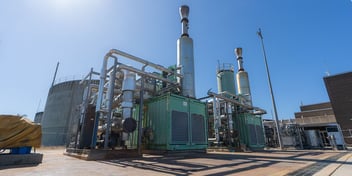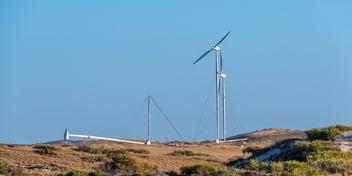Barwon Water to cut emissions with renewable energy networks
Victoria’s Barwon Water is set to transform its service region into a renewable organics network (RON), taking organic material from local businesses and converting it to renewable energy and beneficial agribusiness products.
Barwon Water’s Strategy 2030 aims to achieve zero waste, zero emissions and 100% renewable electricity use, and the utility is well on its way to achieving this goal, with one RON project currently under construction at the Colac Water Reclamation Plant and another under investigation within the wider Geelong region.
Barwon Water General Manager Infrastructure and Technology Shaun Cumming explained the utility's move towards establishing these networks has been driven by a need to meet significant sustainability challenges.
“There have been a few key drivers that led to our investigation of renewable organics networks at a regional level,” Cumming said.
“Firstly, the water industry is one of the biggest greenhouse gases emitters because water is heavy to move around and energy-intensive to treat. Secondly, sending waste to landfill is costly and landfill space is running out. As well as that, landfill is also a large emitter of greenhouse gases.
“Furthermore, as we move towards more renewable energy sources, we need to find dispatchable energy sources to feed into the grid. With these drivers in mind, we engaged with our region in terms of looking at what we could do to provide regional benefit.”
Big targets
While sustainable practices are on the rise throughout industries around Australia, Cumming said water utilities are in a particularly useful position to achieve challenging targets due to the technology and assets they already manage and the relationships they have with industry and councils in their region.
“We have big targets. By talking with councils and industry, we found that we all have these common challenges. Our aim is to leverage the water infrastructure we already have to recycle organic material and create a renewable energy, as well as agribusiness products and jobs,” Cumming said.
“We use a natural organic process that harnesses the natural bacterial breakdown of organic material. The biogases that are created through this process are a resource. We harness the natural biogases created from our digester, and apply it to create electricity and hot water.
“The digestate is then used to create beneficial agricultural products. We already have a facility at our Black Rock Wastewater Treatment Plant that recycles this organic material into pellets. Those pellets are used in agriculture across New South Wales, Victoria, South Australia and Tasmania.”
Barwon Water’s first Renewable Organic Network is underway in Colac, and it involves a partnership with Bulla Dairy Foods and Australian Lamb Company, Cumming said.
“These are both really successful Australian businesses with global exports. After consulting with these local businesses, we came up with the Colac RON concept: we take their organic waste, process it through our plant and, in doing so, create biogas, which takes the local water reclamation plant completely off the grid from an electricity perspective,” he said.
“It actually puts further electricity into the grid and then supplies hot water across the road, back to the Australian Lamb Company, offsetting their gas use.
“By the end of 2022, we'll be providing electricity into the grid and feeding the hot water across the road to the Australian Lamb Company. The renewable energy production produced offsets about 6300 tonnes of carbon emissions per year.”
Leading in the circular economy
Barwon Water also has a three-megawatt solar facility at the Black Rock Wastewater Treatment Plant and a solar and battery facility at its main water treatment plant as part of its Strategy 2030 renewable energy aims.
Cumming said the innovative approach to devising the RON networks was inspired by the huge commitment made in Barwon Water’s Strategy 2030.
“The combination of all these initiatives will get us to our 2030 target of zero waste and 100% renewable energy, which is great. When we first started out, we didn't know how we're going to get there. But there's nothing like setting yourself a significant stretch target to make you think differently,” he said.
“The goal has created some great innovation in terms of us having to think differently. Furthermore, we reserved a percentage of the target that we wanted to achieve within our region to provide regional benefits.
“We wanted 40% of the renewable energy we generated to be associated with initiatives in our region that created regional benefit. This mindset is really what led us down the path of establishing the RON.”
Cumming said the utility is now proud to be able to show the leading role the water industry can play in the circular economy.
“It's not just about water doing something in isolation. We're working in strategic partnerships with other agencies and businesses in our region. And once you start something like this, it creates a catalyst for other initiatives. Opportunities start to emerge everywhere,” he said.
“The water industry has the power to take a leading role in terms of establishing long-term trusted relationships between councils and industries in the regions that they service to help facilitate a joint solution.”
Aside from the Colac RON, which is due for completion at the end of this year, the second project, which will involve six local councils, is investigating taking kerbside organic waste and converting it to renewable energy.
The partnership will look at the viability of a purpose-built facility likely located on a Barwon Water site. If all key investigation milestones are met, Barwon Water would expect completion of the facility by the end of 2023.


